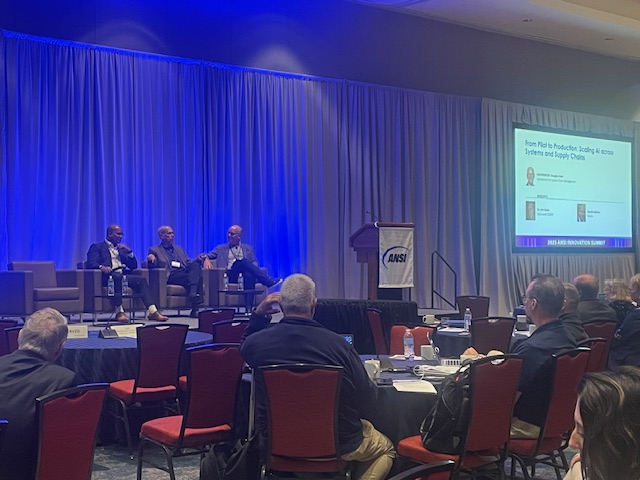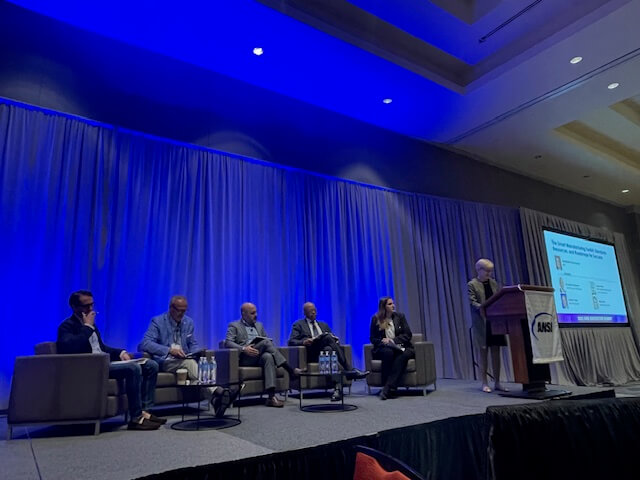
10/30/2025
AI is transforming manufacturing operations, powering everything from collaborative robots that can work safely alongside teams on shop floors to predictive maintenance systems that prevent equipment failures before they happen. More than 100 standards professionals gathered in Rockland, MD, during ANSI’s inaugural Innovation Summit to explore not just what AI can do for manufacturing, but how organizations can scale it responsibly, equitably, and competitively.
Standards are the Bridges to Industry-Wide Revolution
“AI in manufacturing has moved from possibility to proof,” said Dr. Laurie E. Locascio, ANSI president and CEO. “The conversation has fundamentally changed. Just twelve months ago, most manufacturers were still asking whether AI could deliver value. Today, they’re asking how fast they can successfully scale it.”
As U.S. manufacturers harness AI to sharpen their competitive edge in global markets, Locascio also emphasized that standards help enable interoperability between manufacturing systems. “Standards are the common language that lets a sensor in Detroit talk to a system in Denver. They’re the guardrails assuring AI decisions are transparent, auditable, and safe. They’re the bridges that transform individual innovations into industry-wide revolution. Without them, we have automation chaos. With them, we have American manufacturing resurgence.”
Keynote speaker Elham Tabassi, director of the Artificial Intelligence and Emerging Technology Initiative and senior fellow, Global Economy and Development for The Brookings Institution, focused her remarks on enabling AI adoption as traditional manufacturing transitions to more modern approaches. Tabassi emphasized that trust remains one of the biggest challenges facing AI adoption today, stemming from a lack of transparency; distribution and security concerns; unpredictability; and performance gaps.
From Pilot to Production: Scaling AI across Systems and Supply Chains
The morning session highlighted the critical gap between AI pilot projects and enterprise-wide deployment in manufacturing. While manufacturers have demonstrated AI’s potential in specific use cases, many struggle to scale these successes across operations and supply chains.
Moderator Douglas Kent, executive vice president, corporate and strategic alliances, Association for Supply Chain Management (ASCM), led a discussion with panelists Dr. Jim Davis, vice provost emeritus and special advisor on smart manufacturing, Office of Research and Creative Activities, UCLA, and executive oversight, CESMII; and Gerald Jackson, vice president of strategy, supply chain management solutions evangelist, Oracle. Together, they examined why this scaling problem persists and what manufacturers must do differently to succeed—starting with the problem rather than the technology, to fixing data infrastructure, and synchronizing talent development with technology adoption.
Fireside Chat: Building Tomorrow’s Manufacturing Workforce
This expert discussion between Shalin Jyotishi, founder and managing director of the Future of Work and Innovation Economy Initiative at New America, and Dr. Roy Swift, executive director, Workcred, addressed the critical challenge of aligning workforce development with rapid AI adoption in manufacturing. Jyotishi and Swift emphasized that work-based learning is key, by coupling education and work environments and leveraging available resources from community colleges and industry organizations.
Human + AI Teams: The Smart Manufacturing Workforce
Panelists at the smart manufacturing workforce session explored how standards development organizations and industry consortia can support manufacturers navigating disruptive technologies through standards, resources, and collaborative frameworks. Experts included moderator Christine Bernat, associate director, standards facilitation, ANSI; Dr. James Dickerson, director, ASCET Center of Excellence; Sergio Sanchez, director, ASTM Additive Manufacturing Center of Excellence; Christian Thiele, senior director, global ground vehicle standards, SAE International; and Walter Zoller, global product standards and regulations, Rockwell Automation.
The discussion addressed both the practical tools available and the strategic shifts needed to accelerate standards development while maintaining quality and trust. Panelists agreed that standards enable innovation, making processes flow smoothly and ultimately more efficiently, and that collaboration is essential.
What’s Next? Charting the Path Forward
During the final session, Mary Saunders, senior vice president, government relations and public policy of ANSI, led an interactive dialogue on the main challenges, priorities, and opportunities for AI standards development. Through polling and discussion, attendees identified interoperability across systems and platforms as the top priority for standards development efforts. Data governance and sharing protocols also emerged as high priorities, along with standards for AI transparency and auditability and cybersecurity and risk management. Participants expressed that standards are essential for trust, safety and innovation.
Recordings from this event will be posted on ANSI’s website. ANSI thanks all speakers, moderators, panelists, and attendees for their participation.

